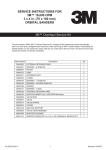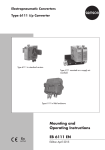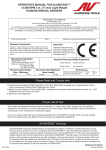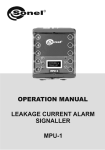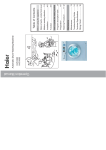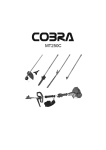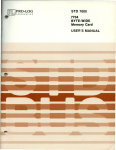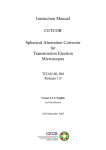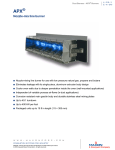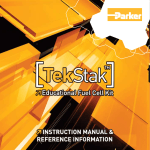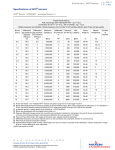Download 3M™ ROS Overhaul Svc Kit Instruction 20346, 3" 77mm, 12000RPM
Transcript
SERVICE INSTRUCTIONS FOR 3M™ 12,000 RPM 3 in. (77 mm) RANDOM ORBITAL SANDERS 3M™ Overhaul Service Kit The part number 20346, 3M™ Overhaul Service Kit, contains all the replacement parts that naturally wear over time and a straightforward manual to make servicing an 3M™ sander simple. Overhauling the Random Orbital Sander can be made even easier with the use of the above Service Tools. The Service Tools also reduce the chance of improper assembly. Part Number 34-8700-5192-6 Description Qty 3MA0040 EXTERNAL RETAINING RING 1 3MA0021 BEARING - 2 SHIELDS 1 3MB0005 ROTOR 1 3MA0010 VANE 5 3MA0041 WOODRUFF KEY 1 3MA0042 O-RING 1 3MA0019 BEARING - 2 SHIELDS 1 3MA0162 BEARING - NO SEAL/SHIELDS 1 3MA0196 SPACER 1 3MA0161 BEARING - 1 SEAL 1 3MA0039 INTERNAL RETAINING RING 1 3MA0068 MUFFLER INSERT 1 3MA0062 INTERNAL MUFFLER 1 3MA0009 VALVE SEAT 1 3MA0007 VALVE 1 3MA0014 VALVE SPRING 1 3MA0043 O-RING 1 3MA0008 VALVE STEM ASSEMBLY 1 3MA0166 MUFFLER HOUSING 1 3MA1416 INSTRUCTIONS FOR 3 in. ROS OVERHAUL SERVICE KIT 1 Revision 10/03/07 12,000 RPM 3 in. (77 mm) ROS Service Instructions NOTICE: To receive any expressed or implied warranty, the tool must be repaired by an authorized Service Center. The 3 in. (77 mm) Random Orbital Sander Service Instructions section provided is for use after completion of the warranty period. DISASSEMBLY INSTRUCTIONS Changing Grips: 1. The Grip has two “tabs” that wrap around the body of the sander under the inlet and exhaust. Use a small screwdriver to pick out one of the “tabs” of the Grip, then continue to go underneath the Grip with the screwdriver and pry the Grip off the sander. To install a new Grip, hold the Grip by the tabs making them face outward, align the Grip and slide it under the Throttle Lever then press the Grip down until it seats onto the top of the sander. Make sure the two “tabs” seat under the inlet and exhaust. Motor Disassembly: 1. Lightly secure the tool in a vise using the T-7 Service Collar or padded jaws. Use a 17 mm Pad Wrench to secure the Spindle and spin the Pad counter clock-wise off the spindle. 2. Remove the Lock Ring with the T-6 Motor Lock Ring Wrench/Spindle Puller Tool. The motor assembly can now be lifted out of the Housing. Remove the O-Ring from the Lock Ring. 3. Secure the motor assembly by clamping the Shaft Balancer in a padded jaw vise and remove the Retaining Ring from the end of the Shaft Balancer and the O-ring from the Cylinder. 4. Remove the Rear Endplate. This may require supporting the Rear Endplate with a bearing separator. Use a light press force to push the Shaft Balancer through the Bearing. Then remove the Cylinder, Vanes and the Rotor. Remove the Key from the Shaft Balancer. Support the Front Endplate with a bearing separator and use a light press force to push the Shaft Balancer through the bearing. It may be necessary to remove the Bearing with a bearing separator if it came out of the Front Endplate and stuck to the shaft of the Shaft Balancer. 5. Remove the Bearing(s) from the Endplates by using the T-8 Endplate Bearing Removal Tool to press out the Bearings. Shaft Balancer and Spindle Disassembly: 1. Grip the shaft end of the Shaft Balancer in a padded vise. With a thin screwdriver pick out the slotted end of the Retaining Ring and peel out. 2. Screw the female end of the T-11 5/16-24 to 1/4-20 Adapter into the male end of the Service Wrench. Screw the Service Wrench assembly into the Spindle Assembly until hand tight. Apply a gentle heat from a propane torch or hot air gun to the large end of the Shaft Balancer until it is about 212° F (100° C) to soften the adhesive. Do not over heat. Remove the Spindle Assembly by using the Slider to give sharp outward blows to the Spindle. Allow the parts to cool so they are safe to handle. 3. Remove the Retaining Ring from the Spindle Assembly. Use a small Bearing Separator to remove the Bearing, Shim, Bearing, Shim and the Washer from the Spindle Assembly. 4. The bearing shield components are held in place by the 34-8700-5192-6 light press fit of the Retainer. These components can be damaged during removal and may need to be replaced if removed. To remove the Retainer, use an O-ring pick or a #8 sheet metal screw to grip and pull out the Retainer. Remove the Valve and Filter from the bore in the Shaft Balancer. If the Retainer and Valve were not damaged, they can be reused. However, the Filter should be replaced on re-assembly. Housing Disassembly: 1. For Non-Vacuum (NV) and Central Vacuum (CV) machines follow steps A – B below (unless otherwise noted). For Self Generated Vacuum (SGV) machines disregard steps A – E and move onto Step G below. A. Unscrew the Muffler Housing from the Housing. Remove the Bronze Muffler from the Muffler Housing (if applicable). Remove the Muffler from the Muffler Housing. For NV machines move onto B. For CV machines move onto C. B. Remove the 3 in. (77 mm) Non-Vacuum Shroud. For NV machines move onto step 2. For Central Vacuum (CV) Exhaust machines: C. Remove the Screw, Washer and Nut. D. Remove the Ø ¾ in. (19 mm) CV Swivel Exhaust Assembly (Optional) or the Ø 1 in. (28 mm) CV Swivel Exhaust Assembly (Standard) from the 3 in. (77 mm) Shroud. E. Remove the 3 in. (77 mm) Shroud from the Housing. Move onto step 2. For Self Generated Vacuum (SGV) Exhaust machines: F. Unscrew the SGV Retainer with an 8 mm hex key. G. Remove the Ø 1 in. (28 mm) Hose SGV Swivel Exhaust Assembly (Standard) or Ø ¾ in. (19 mm) Hose SGV Swivel Exhaust Assembly (Optional) from the Adapter. H. Pull the SGV Retainer out of the bore of the Swivel Exhaust Assembly and remove the two O-Rings. I. Remove the 3 in. (77 mm) Shroud from the Housing. 2. Place the Speed Control to the midway position and remove the Retaining Ring. NOTE: If the machine is one of the vacuum models, the vacuum exhaust assembly must be removed (See section 1 above, for removal) before the Retaining Ring can be removed with lock ring pliers. The Speed Control will now pull straight out. Remove the O-ring. 3. Unscrew the Inlet Bushing Assembly from the Housing. Remove the Spring, Valve, Valve Seat, Valve Stem and the O-ring from the Valve Stem. 4. Press out the Spring Pin from the Housing and remove the Lever. ASSEMBLY INSTRUCTIONS NOTE: All assembly must be done with clean dry parts and all bearings are to be pressed in place by the correct tools and procedures as outlined by the bearing manufacturers. Housing Assembly: 1. Install Throttle Lever into Housing with Spring Pin. 2. Lightly grease the O-Ring and place it on the Speed Revision 10/03/07 Control. Install the Valve Stem and O-ring (cleaned and lightly greased) and insert the Speed Control into Housing in the midway position. Install Retaining Ring. CAUTION: Make sure the Retaining Ring is completely snapped into groove in the Housing. 3. Install the Valve Seat, Valve and the Spring. Coat the threads of the Inlet Bushing Assembly with 1 or 2 drops of 3M Rite-Loc TL22 or equivalent non-permanent pipe thread sealant. Screw the Inlet Bushing Assembly into the inlet port on the Housing. Torque to 60 in/lbs (6.77 Nm.) 4. For NV and CV machines follow the steps A - C. For SGV machines follow the steps G - J. This section is for Central Vacuum (CV) and Non-Vacuum (NV) machines. A. Place a clean Muffler all-the-way into the chamber of the Muffler Housing. Press the Bronze Muffler into the bore of the Muffler Housing (if applicable). B. Screw the Muffler Housing assembly into the Housing until hand tight. Use a 21 mm socket/torque wrench combination to torque the Muffler Housing. Torque to 20 in/lbs (2.25 Nm). For NV machines move onto C. For CV machines move onto step D. C. Install the 3 in. (77 mm) Non-Vacuum Shroud onto the Housing by working the Shroud over and around the bottom of the Housing flanges. Make sure the line up slots on the Housing and tabs on the Shroud are engaged. Move onto the “Spindle Bearings, bearing shield and Shaft Balancer Assembly” Section. This section continued from Section I for Central Vacuum (CV) Exhaust machines: D. Install the 3 in. (77 mm) CV Shroud on to the Housing by working the shroud over and around the bottom of the Housing flanges. Make sure the line up slots on the Housing and tabs on the Shroud are engaged. E. Slide the inlet end of the Ø ¾ in. (19 mm) CV Swivel Exhaust Assembly (Optional) or the Ø 1 in. (28 mm) CV Swivel Exhaust Assembly (Standard) into the exhaust port of the 3 in. (77 mm) CV Shroud until it hits the stop on the CV Swivel Exhaust Assembly. Make sure the key on the CV Swivel Exhaust Assembly bracket is aligned and engaged with the keyway on the Housing. F. Place the Washer over the Screw. Thread the screw into the CV Swivel Exhaust Assembly or Ø 1 in. (28 mm) CV Swivel Exhaust Assembly (Optional) and Housing until the end of the screw is flush with the inside surface of the Housing. Place the Nut into the cavity of the Housing and thread the screw into the nut until tight. Move onto the “Spindle, bearing shield and Shaft Balancer Assembly” Section. For Self Generated Vacuum (SGV) Exhaust machines: G. Install the 3 in. (77 mm) Shroud onto the Housing by working the shroud over and around the bottom of the housing flanges. Make sure the line up slots on the Housing and tabs on the Shroud are engaged. Slide the SGV Exhaust Adapter Fitting into the exhaust of the 3 in. (77 mm) CV Shroud. H. Lightly grease two O-Rings and place them into the two grooves in the SGV Retainer. I. Put the SGV Retainer into the mounting hole of the Ø 1 in. (28 mm) Hose SGV Swivel Exhaust Assembly (Standard) or the Ø ¾ in. (19 mm) Hose SGV Swivel Exhaust 34-8700-5192-6 Assembly (Optional). J. Slide the Swivel Exhaust Assembly into the SGV Exhaust Adapter Fitting while at the same time inserting the SGV Retainer into the sander Housing exhaust port. Screw the SGV Retainer into the threaded exhaust port on the Housing with an 8 mm hex key. Torque to 45 in/lbs (5.08 Nm. ). Spindle Bearings, Bearing Shield and Shaft Balancer Assembly: 1. Place the T-5A Spindle Bearing Pressing Tool Base onto a flat, clean surface of a small hand press or equivalent with the spindle pocket facing upward. Place the Spindle into the spindle pocket with the shaft facing upwards. See Figures 1 and 2. 2. Place theWasher on the Spindle shaft with the curve of the Washer facing out so that the outside diameter of the Washer will contact the outer diameter of the Bearing (one seal). Lay the Shim on the shoulder of the Spindle. Place the Bearing (one seal) on the Spindle with the seal side toward the Washer. NOTE: Make sure that both the inner and outer races of the Bearings are supported by the Bearing Press Tool when pressing them into place. Press the Bearing onto the shoulder of Spindle using the T-5B Spindle Bearing Pressing Tool Top as shown in Figure 2. 3. Place the Shim over the Spindle shaft and onto the face of the Bearing making sure it is on center. Press the (no seals/shields) Bearing down using the T-5A Spindle Bearing Pressing Tool Top, being careful to make sure the Shim is still centered on the vertical axis of the Spindle shaft and Bearing. See Figure 3. NOTE: When the Spindle Assembly is done correctly, the Bearings will rotate freely but not loosely and the Shim can be moved but will not slide or move by gravity. 4. Secure the Retaining Ring onto the Spindle Assembly making sure it is completely snapped into the groove. Set the Spindle Assembly aside. 5. Take the Filter and center it on the small bore that the original filter was in before removal. With a small diameter screwdriver or flat end rod, press the Filter into the bore until it is flat in the bottom of the bore. Place the Valve into the bore so it is oriented correctly, then press the Retainer into the bore until it is flush with the bottom of the bearing bore. 6. Apply a pin head size drop of 3M Rite-Loc TL71 or equivalent to the outside diameter of each of the bearings on the Spindle Assembly. Spread the drop of bearing locker around both bearings until distributed evenly. CAUTION: Only a very small amount of bearing locker is needed to prevent rotation of the bearing OD. Any excess will make future removal difficult. Place the Spindle Assembly into the bore of the Shaft Balancer and secure with the Retaining Ring. CAUTION: Make sure that the Retaining Ring is completely snapped into the groove in the Shaft Balancer. Allow the adhesive to cure. Motor Assembly: 1. Use the larger end of the T-13 Bearing Press Sleeve to Press the front Bearing (with 2 Shields) onto the shaft of the Shaft Balancer. 2. Slide the Front Endplate with the bearing pocket facing down onto the Motor Shaft. Gently press the Front Endplate onto the front Bearing using the larger end of the T-13 Bearing Press Sleeve until the front Bearing is Revision 10/03/07 Bearing Press Tool Top Bearing Shim Shim Washer Spindle Press Tool Base Figure 1 Figure 2 seated in the bearing pocket of the Front Endplate. CAUTION: Only press just enough to seat the bearing into the pocket. Over-pressing can damage the bearing. 3. Place the Key into the groove on the Shaft Balancer. Place the Rotor onto the shaft of the Shaft Balancer, making sure that it is a tight slip fit. 4. Oil the five Vanes with a quality pneumatic tool oil and place in the slots in the Rotor. Place the Cylinder Assembly over the Rotor with the shorter end of the Spring Pin engaging the blind hole in the Front Endplate. NOTE: The Spring Pin must project .060 in. (1.5 mm) above the flanged side of the Cylinder. 5. Press fit the rear (2) Bearing (2 shields) into the Rear Endplate with the T-1B Bearing Press Tool. Make sure the T 1B Press Tool is centered on the O.D. of the outer race. Lightly press fit the Rear Endplate and Bearing Assembly over the Shaft Balancer using the small end of the T-13 Bearing Press Sleeve. The sleeve should press only the inner race of the bearing. IMPORTANT: The Rear Endplate and Bearing Assembly is pressed correctly when the Cylinder is squeezed just enough between the Endplates to stop it from moving freely under its own weight when the shaft is held horizontal, but be able to slide between the Endplates with a very light force. If pressed to tightly the motor will not run freely. If the pressed assembly is to loose, the motor will not turn freely after assembly in the Housing. 6. Secure the assembly by placing the Retaining Ring in the groove of the Shaft Balancer. CAUTION: The Retaining Ring must be placed so that the middle and two ends of the hoop touch the Bearing first. Both raised center portions must be securely “snapped” into the groove in the Shaft Balancer by pushing on the curved portions with a small screwdriver. 7. Carefully screw the Lock Ring into the Housing using the 34-8700-5192-6 Figure 3 T-6 Motor Lock Ring Wrench. Torque to 60 in/lbs (6.77 Nm.) NOTE: A simple technique to assure first thread engagement is to turn the lock ring counter clockwise with the service tool while applying light pressure. You will hear and feel a click when the lead thread of the lock ring drops into the lead thread of the housing, then turn clockwise to tighten. 8. Spin on a new Pad and hand tighten it using a 17 mm Pad Wrench. Testing: Place 3 drops of quality pneumatic air tool oil directly into the motor inlet and connect to a 90 psig (6.2 bar) air supply. The tool should run between 11,500 and 12,000 RPM for 12,000 RPM machines when the air pressure is 90 psig (6.2 bar) at the inlet of the tool while the tool is running at free speed. This free speed will be about 500 RPM to 1,000 RPM less when a Vacuum or Hook Face Pad is used because of wind resistance. This will not affect performance when sanding. Revision 10/03/07 Troubleshooting Guide Symptom Low Power and/or Low Free Speed Air leakage through the Speed Control and/or Valve Stem. Vibration/Rough Operation 34-8700-5192-6 Possible Cause Solution Check air line pressure at the Inlet of the Insufficient Air Pressure Sander while the tool is running at free speed. It must be 90 psig (6.2 Bar). See the “Housing Disassembly” section for Muffler removal. The Muffler can be back flushed with a clean, suitable cleaning solution until all contaminates Clogged Muffler(s) and obstructions have been removed. If the Muffler can not be properly cleaned then replace it. Replace Muffler Insert (See the “Housing Assembly” Section). Clean the Inlet Screen with a clean, suitPlugged Inlet Screen able cleaning solution. If Screen does not come clean replace it. Install a complete set of new Vanes (all vanes must be replaced for proper operation). Coat all vanes with quality One or more Worn or Broken Vanes pneumatic tool oil. See “Motor Disassembly” and “Motor Assembly”. Check for proper Motor alignment and Lock Ring engagement. Check for Internal air leakage in the Motor Housing damaged O-Ring in Lock Ring groove. indicated by higher than normal air conRemove Motor Assembly and Re-Install sumption and lower than normal speed. the Motor Assembly. See “Motor Disassembly” and “Motor Assembly”. Overhaul Motor. Contact authorized Motor Parts Worn Service Center. Replace the worn or broken Bearings. See “Shaft Balancer and Spindle DisasWorn or broken Spindle Bearings sembly” and “Spindle Bearings, Bearing Shield and Shaft Balancer Assembly”. Disassemble, inspect and replace worn Dirty, broken or bent Valve Spring, Valve or damaged parts. See Steps 2 and 3 in or Valve Seat. “Housing Disassembly” and Steps 2 and 3 in “Housing Assembly”. Only use Pad Sizes and Weights deIncorrect Pad signed for the machine. Only use abrasive and/or interface designed for the machine. Do not attach Addition of interface pad or other material anything to the Sanders Pad face that was not specifically designed to be used with the Pad and Sander. Disassemble the Sander and clean in a Improper lubrication or buildup of foreign suitable cleaning solution. Assemble the debris. Sander. (See “Service Manual”) Replace the worn or broken Bearings. Worn or broken Rear or Front Motor See “Motor Disassembly” and “Motor Bearing(s) Assembly”. For SGV machines add extra washer(s) For vacuum machines it is possible to to the pad spindle to increase the gap have too much vacuum while sanding on a between the pad and shroud. For CV flat surface causing the pad to stick to the machines reduce vacuum through sanding surface. the vacuum system and/or add extra washer(s) to the pad. Revision 10/03/07





